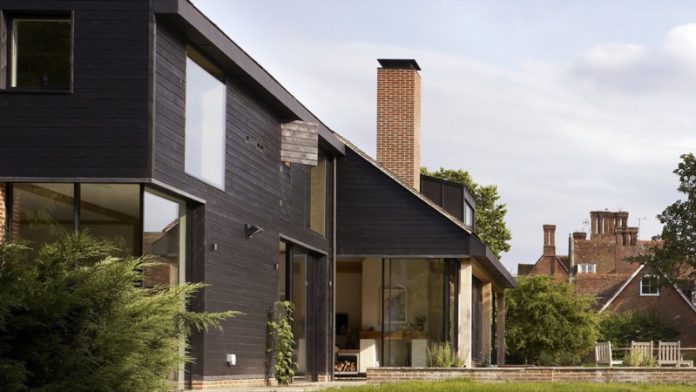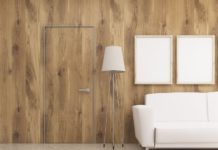Brick and concrete construction has dominated the European heritage of utilising wood as a building material for the previous century. Meanwhile, charred timber cladding is currently making a comeback in architecture because of its visual appeal and environmental sustainability. Timber-clad won the entries for this year’s Residential construction, evidenced by the Renovation Awards.
What Exactly Is Charred Timber Cladding?
Shou Sugi Ban began in 18th-century Japan to charring cedar to colour, weatherproof, and preserve the wood and make it resistant to fire, rot, insects, and UV rays from the sun.
The overall aspect of the cladding is dark and homogenous. However, each wood is quite distinctive. An extraordinary spectrum of subtle purple, blue, and silver tones showing against the charcoal black highlights the texture and grain of the wood. The resulting surface texture may then be brushed or left raw.
Yakisugi, Or The Charring Of Wood, Is A Japanese Tradition
Yakisugi, or charring wood, was invented to preserve the wood. Because of this discovery, Japanese Cedar panels have a longer lifespan thanks to a controlled burn. Japanese charred timber cladding has taken centre stage in modern design with its stunning black finish. It would see a rebirth all across the globe.
Timber Preserving From The Elements By Using The Charring Method
Timber is a naturally occurring product with over 5000 different wood species to choose from. It is simple to shape and cut, naturally solid and long-lasting. Nonetheless, it is a substance with a high hygroscopicity. As moisture levels fluctuate, it expands and shrinks. Europe and Japan’s shifting seasons may cause it to break, bend and decay.
Oils, varnish, paints, and other protective coatings are often used on wood across Europe. It serves as a protective layer that shields the wood from fluctuating moisture levels. Reapplying is necessary to ensure weatherproofing.
Instead of using a coating, the Japanese opted to burn the surface instead of heating it. Natural resins are extracted from the wood by controlled burning, leaving a thin, carbon-rich coating. This weatherproofing method is long-lasting since it is integrated into the wood. It is often treated with an oil finish for enhanced durability.
Insects Are Deterred By Charred Wood
Timber decay is also caused by insects, mould, and fungus, among other things. Wood burrowing insects have caused holes in wooden beams all around the globe (most generally known as woodworm). A company that can apply a wide range of wood-protective coatings may significantly reduce infestations. Insects are scared of the carbon layer on charred wood, so they aren’t necessary.
Mould and fungus need concrete that is wet and well-oxygenated. To avoid these situations, methods such as kiln drying lumber, providing protective coatings, or charring might be used.
Charred Timber Is Fire Resistant
Contrary to popular belief, charring wood strengthens its fire resistance. It is possible because the regulated procedure eliminates the delicate outer cells, which ignite fast. It is left with the hard, lignin cells, which need much hotter temperatures to catch fire.
As a result, burnt lumber has a different thermal conductivity than untreated wood. However, it does not conform to building regulations, so additional fire-retardant treatment is possible if required.
Yakisugi Provides Additional Stability
Another unexpected advantage of charring wood is that it makes it stronger. If the wood is weak, it’s natural to assume that removing its outer coat will make it even weaker. Because it clears moisture, the procedure yields a more robust final product.
The Charm Of Charred Wood
Finally, the charred wood’s final appearance has a unique aesthetic quality. In addition to the smooth, polished surface, the Japanese could achieve different results by varying the brushing and finishing procedure.
There are numerous new avenues to explore when putting a modern spin on a classic method. Using Yakisugi on a variety of wood species has allowed us to understand better and enhance the unique characteristics of each piece of wood.
When burnt, it produces a muscular delineation between the wood and grain, which may use any RAL colour to produce startling effects to match strong exterior and interior decorating. Furthermore, Charred Larch and Accoya have distinct grain patterns that provide a unique and appealing finish. Depending on your preference, charred cedar timbers can be left as is, gently brushed for a smooth finish, or given a grain-definition heavy brush.
Each natural board has a grain detail, giving the Japanese charred timber cladding a one-of-a-kind look. For exterior treatments on residential and commercial buildings, which may enhance this grain depending on the burn depth.
Conclusion
Charred timber cladding has been employed to stunning effect in ancient and modern architecture. Indoor and outdoor applications are in high demand, and this isn’t just a fad. A beautiful, long-lasting, and environmentally friendly building material may be made using the legacy method. It’s both visually appealing and environmentally friendly.




